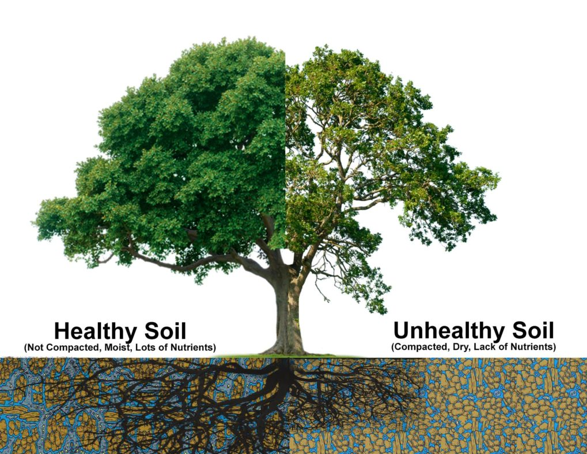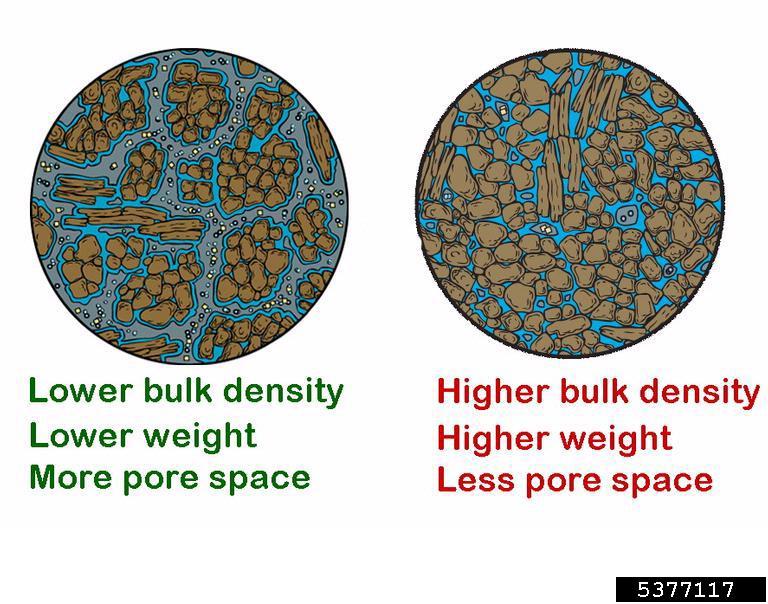Caring for landscapes means recognizing stress. Unfortunately, not all stressors can be seen by the naked eye; such is the case for soil compaction.
Heavily compacted soil creates an unnatural, unsupportive environment that fails to support root systems and can be detrimental to plants.
Soil compaction can lead to:
- Overall decline in the tree’s health
- Canopy dieback (deadwood)
- Yellowing leaves
- Early leaf drop
- Early color change
- Poor plant growth
- Presence of secondary invaders (insects who attack weaker trees), especially Borers
- Grass not growing under canopies
Natural Forest vs Urban Area: How does soil compaction affect soil?
In the natural forest, the topmost area of soil contains 50% oxygen. Does this number seem small? If so, you may be surprised by the next percentage. 10%, a much smaller percentage, is the amount of oxygen typically found in the top six inches of urban soil.
Why does this matter? Lack of oxygen and pore space ultimately reduce nutrient and water intake.
Symptoms then begin showing above-ground which ignite the worry cycle among homeowners. Homeowners may begin seeing yellowing leaves, early defoliation, or poor plant growth, which could point to a nutrient deficiency. Drought symptoms, on the other hand, may indicate reduced water intake.
Why does this happen? Due to the inherent activities that take place, soil compaction is worse in urban areas than in the natural forest.
Specifically, this difference is due to an urban area’s greater likelihood of encountering the following:
- Construction, often deliberate for housing foundations
- High traffic, whether by foot, vehicle, or equipment
- Wet soil, especially susceptible to compaction
At its worst, soil compaction can lead to plant mortality. Altogether, these consequences make it important to proactively engage in soil management practices to escape the silent killer that is soil compaction.
Curious about what other stressors might be taking place in your yard? Find out here.
How do you fix soil compaction?
80% of urban tree decline results from poor soil conditions. Don’t let this happen to your landscape! Remember: the best way to care for your plants is to treat them proactively. This means before symptoms start showing up.
Here are a few ways you can proactively combat soil compaction:
- Soil Aeration:
- Loosens the soil
- Enables new roots to grow
- Gives older roots room to breathe
- Creates pore space that mimics natural forest
- Promotes plant health and growth
- Vertical Mulching & Soil Augmentation:
- Creates holes in Critical Root Zone (CRZ)
- Replaces holes with missing organic matter
- Improves soil composition
- Goes a step further from soil aeration
- Bio-stimulants are an organic method of proactively caring for plants and their soil. For more information, stay tuned for next week’s article.
Our Certified Arborists will be able to apply the treatment best suited to your landscape’s needs.
Tip: Soil treatments are great to do in the fall. It’s best to get them done now so your landscape can flourish in the spring.

WORRIED ABOUT SOIL COMPACTION?
OR CALL 703-573-3029




